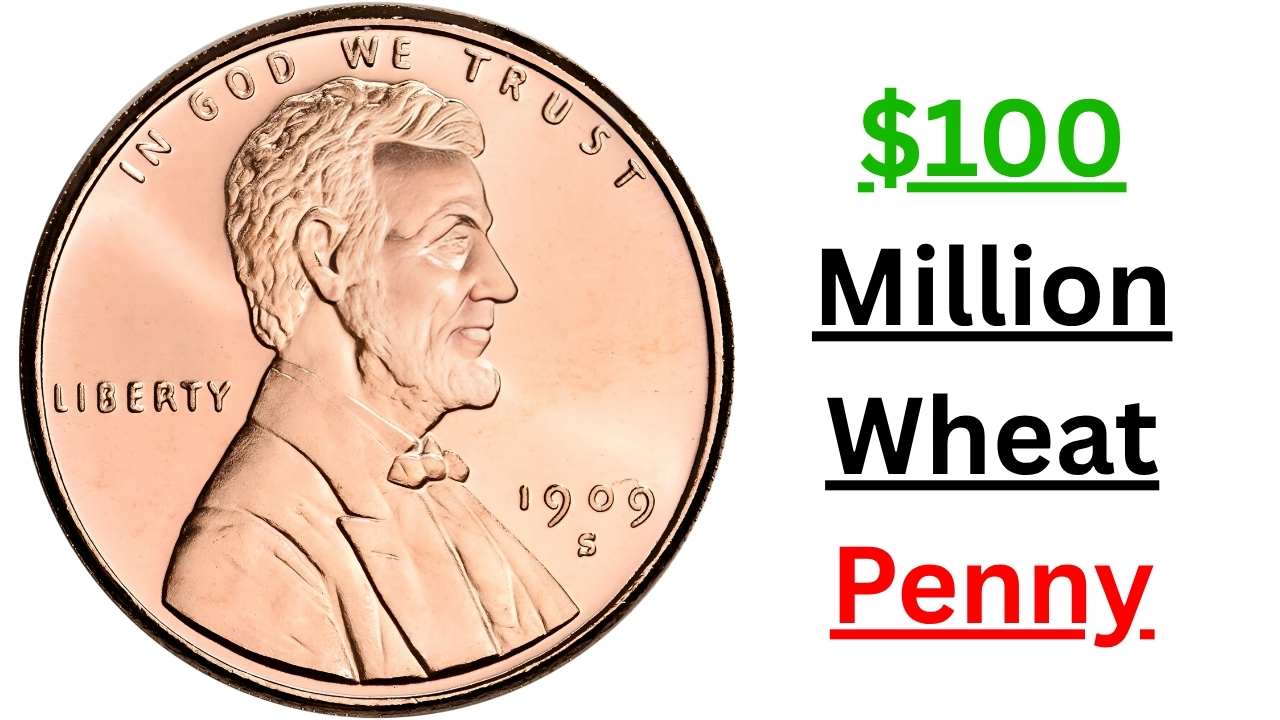$100 Million Wheat Penny : The world of coin collecting continues to fascinate both seasoned numismatists and casual enthusiasts, particularly when it comes to valuable wheat pennies that might still be circulating.
While claims of $100 million wheat pennies are extremely exaggerated, some wheat cents do command impressive prices at auction, making it worthwhile to understand these historic coins and their actual market values.
History of the Wheat Penny
The Lincoln wheat penny, officially known as the Lincoln cent, was minted from 1909 to 1958.
These coins feature Abraham Lincoln on the obverse (front) and two wheat stalks on the reverse (back), giving them their popular “wheat penny” nickname.
Designed by Victor David Brenner, these coins replaced the Indian Head cent and became one of America’s most recognizable pieces of currency.
The wheat penny design commemorated the 100th anniversary of Lincoln’s birth, making the United States the first nation to feature an actual person on a regularly circulating coin.
The wheat stalks on the reverse symbolized America’s agricultural strength, particularly appropriate given Lincoln’s rural background.
Key Dates and Valuable Varieties
Several wheat pennies are genuinely valuable, though none approach anything close to $100 million. The most sought-after varieties include:
The 1909-S VDB penny, one of the first wheat pennies minted, had a limited production run of only 484,000 coins. High-grade examples can sell for several thousand dollars.
The designer’s initials (VDB) caused controversy, leading to their quick removal and creating this scarce variety.
The 1914-D penny, with only 1,193,000 minted, represents another key date.
Well-preserved specimens command prices ranging from hundreds to thousands of dollars depending on condition.
The 1922 “No D” penny resulted from a mint error where the Denver mint mark was missing.
This variety is particularly valuable, with pristine examples selling for tens of thousands of dollars.
The 1931-S penny had a low mintage of just 866,000 coins, making it scarce in all conditions.
Even circulated examples carry premiums, while mint state coins fetch significant sums.
The 1943 copper penny is perhaps the most famous error coin. During World War II, pennies were made from steel to conserve copper for the war effort.
A few copper planchets remained in the machinery, creating extremely rare 1943 copper cents. Genuine examples have sold for over $200,000, though many counterfeits exist.
Identifying Valuable Wheat Pennies
Determining whether you have a valuable wheat penny requires careful examination. First, check the date and mint mark, located below the date.
San Francisco (S) and Denver (D) mint marks often indicate scarcer varieties. Philadelphia coins typically have no mint mark.
Condition plays a crucial role in value. Coins are graded on a scale from Poor (P-1) to Perfect Mint State (MS-70).
Even common date wheat pennies in exceptional condition can be valuable. Look for coins with sharp details, original luster, and no significant wear or damage.
Use a magnifying glass to examine details carefully. On the 1909-S VDB, look for the tiny VDB initials on the reverse near the bottom rim.
For 1943 pennies, test with a magnet – steel pennies are magnetic while rare copper ones are not.
Current Market Values
Realistic values for wheat pennies vary dramatically based on date, mint mark, and condition.
Common date wheat pennies in average circulated condition typically sell for 3 to 10 cents each. Better dates in similar condition might fetch 25 cents to several dollars.
Key date coins in fine to extremely fine condition range from $20 to several hundred dollars.
The same coins in mint state can multiply in value, sometimes reaching thousands of dollars.
The rarest varieties in the finest known conditions have sold for six figures at major auctions, but these are exceptional cases.
Where to Find Wheat Pennies
While wheat pennies are no longer commonly found in everyday change, they do occasionally appear.
Check coin rolls from banks, particularly customer-wrapped rolls rather than machine-wrapped ones. Estate sales, flea markets, and garage sales sometimes yield unexpected finds.
Coin collecting shops sell wheat pennies individually or in bulk lots. Online marketplaces offer vast selections but require careful attention to authenticity and accurate grading.
Joining local coin clubs provides access to knowledge and trading opportunities with fellow collectors.
Authentication and Grading
For potentially valuable wheat pennies, professional authentication and grading are essential.
Services like PCGS (Professional Coin Grading Service) and NGC (Numismatic Guaranty Corporation) provide expert evaluation and encapsulation in protective holders.
The cost of grading must be weighed against potential value. Grading fees typically start around $20-30 per coin, making it impractical for common dates.
However, for scarce varieties or high-grade examples, professional grading significantly enhances marketability and value.
Avoiding Scams and Counterfeits
The popularity of valuable wheat pennies has led to numerous counterfeits and altered coins. Be skeptical of deals that seem too good to be true.
Common scams include altered dates, added mint marks, and copper-plated 1943 steel cents passed off as rare copper versions.
Buy from reputable dealers who offer return privileges and authenticity guarantees.
Education remains your best defense – learn the diagnostic features of genuine coins and trust your instincts when something seems suspicious.
$100 Million Wheat Penny Conclusion
While no wheat penny is worth $100 million, these historic coins offer genuine collecting enjoyment and potential value.
Understanding key dates, varieties, and grading helps collectors make informed decisions.
Whether you’re searching pocket change or building a serious collection, wheat pennies provide an accessible entry into numismatics with the possibility of discovering something special.
Remember that the true value often lies not just in monetary worth but in the history these coins represent and the enjoyment of the hunt.










